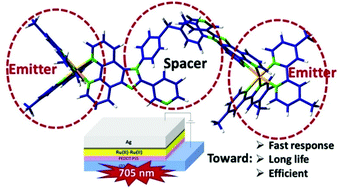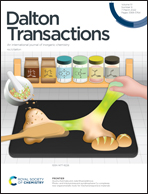New molecularly engineered binuclear ruthenium(ii) complexes for highly efficient near-infrared light-emitting electrochemical cells (NIR-LECs)†
Abstract
From the practical point of view, the stability, response time and efficiency of near-infrared light-emitting electrochemical cells (NIR-LECs) are key factors. By using the high potential of chemical modification potential of the phenanthroimidazole ligand, three new binuclear ruthenium(II) complexes with an alkyl spacer as the NIR-emitter were designed and synthesized. NIR-LECs based on these complexes exhibit near-infrared emission at the maximum wavelength of up to 705 nm and with an EQE of up to 0.72% at 4.0 V, which are among the highest values for NIR-LECs based on cationic binuclear ruthenium(II) complexes reported so far. The lifetimes of NIR-LECs based on binuclear complexes were increased about 1.5-to-4-fold with respect to the ones based on mononuclear complexes. Furthermore, a significant decrease in the turn-on time of NIR-LECs by chemical tethering of a new ionic methylpyridinium moiety from 6.3 to 1.4 minutes was observed. It seems that this combinational modification approach can open a new avenue for practical applications.



 Please wait while we load your content...
Please wait while we load your content...